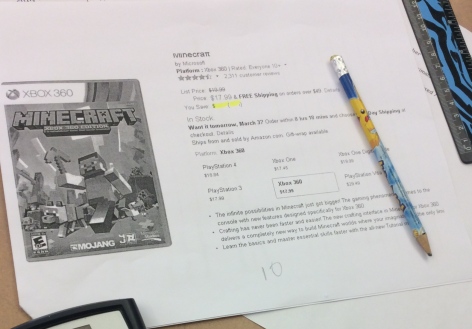
My fourth grade class is learning about discounts. Over the past few years I’ve used so many different activities related to percent off and discounts. This year I decided to use Amazon and shopping prices to help reinforce how to calculate amount saved and discounts. I printed off five different items that were intentionally picked from Amazon. I picked items I thought the students might be interested in. I erased the percent saved and percent off sections that are usually displayed on Amazon. Students were asked to find both of these items and explain their thinking in the process.


Before starting, the class discussed the process used to find percent discounts. This mini-lesson took around 5-10 minutes. During this time I found that the class had a few different misconceptions on how to find the discount after the percent of the number was found. Some students subtracted this from the sale price, while other students wanted to deduct the amount from the original price. After the mini-lesson students went back to their seat and I randomly passed out the sheets to students.
Students were pumped, as they weren’t sure what they’d get. It was great to see the anticipation and soon they got to work. Students took out their calculators and started to find the discounts. Students were able to quickly find the savings, but had some trouble with the percent. Students had a few questions during this process. For some, they used trial-and-error, while others used a precise process to find a solution. Some students had questions about their answer and I questioned the reasonableness of their percent. Students turned in their responses and moved on to the next activity.

I graded the sheets that night and started to notice some trends. The majority of problems seemed to occur during the dividing process. Students were either dividing the decimal by the sale price or regular price to find the discount. Also, some students had percent discounts that weren’t reasonable, such as 1% compared to 10%. I decided to give all my feedback in question form. The idea for this actually originated from one of Fawn’s posts on using a highlighter to give feedback. If students mastered the concept then I indicated that on top of the paper. If not, I wrote questions related to the misconception and didn’t assign a grade on top of the papers.
The next day I gave students the papers back without a grade and asked for students to make a second attempt. This was about half of the class. The rest of the class had a different assignment during this time. I told the students that their first attempt was important but not their final grade for the assignment. Some students were confused but seemed relieved after I communicated that the questions were there to help guide them during the second attempt. I also told the students that their second attempt should be in a different color so I can see the changes that were made. Students completed their second attempts in about 15-20 minutes.


During the next day I passed back the papers and around 90% of the students achieved mastery on this particular assignments. Good news. I had a number of questions from the students related to if we’ll be having second attempts in the future. Not sure yet, but this seemed like a positive step. There were still some students that needed help but the second attempt was a success for most. This second attempt with questions strategy is something I might use in the future. I’ll be selective with it but I feel like it seemed to help students move towards mastering the objective.
I like the ability to scale up or down this activity. For instance, the difficulty of the task could vary significantly simply by blocking out the original price, discount, and percent discount. Instead of finding the discount, students would find the original price (a la Dan Meyer’s 3Act with Amazon prices). I’m wondering how you approach teaching percentages with 4th graders. You mentioned students using calculators, but is there an estimation element to the process? For instance, I saw an item in one of the pictures that was $17.99 from $19.99. Do you stress rounding (in this case, to $18 and $20) and benchmarks (50%, 25%, 10%, 5%, 1%) to estimate an answer before calculating? Do students use ratio tables or double number lines? I’m curious because these strategies have helped my students decide upon the reasonableness of their calculations.
LikeLike
Yes, this activity has a lot of ceiling room. I’m even planning on using a version of it with my fifth graders next week. The students use estimation strategies at first and then use a calculator to find the exact solution. Students usually visualize the amount on a number line and increase or decrease the amount based on the percent. This time I didn’t have students document their estimate. This is something I might consider in the future. It definitely helps with the reasonableness aspect. Generally the 4th graders use the number line instead of ratio tables. Although some students will use fractions as benchmarks and convert them to percent increase/decrease.
Thanks for stopping by and leaving a comment.
LikeLiked by 1 person